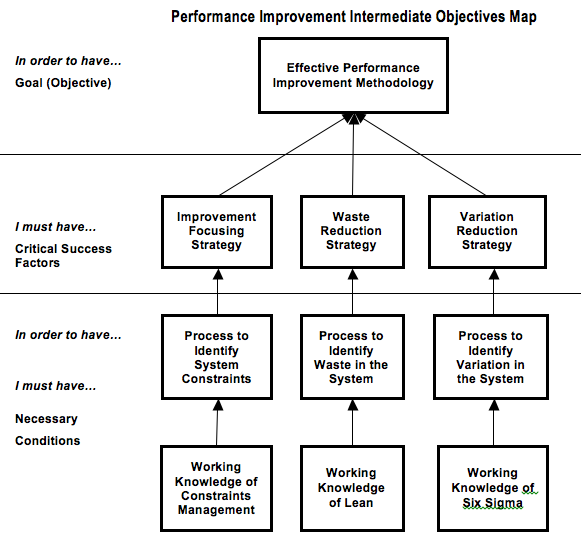
Process Improvement Advice & Best Practices
Intermediate Objectives Map – A Great Planning Tool
If you’re like many people who have gone through a full-fledged Constraints Management Jonah training session to learn Theory of Constraints (TOC) Thinking Processes (TP), you may have come away feeling somewhat overwhelmed by the countless possible applications of all the tools in the suite. Freshly minted Jonahs shouldn’t feel dissuaded if they don’t quite feel like ‘a Jonah’ right out of the gate. The old adage applies with TP: “easy to learn, a lifetime to master.” With practice and the right mentor, before long, these logic trees can become a valuable part of the continuous improvement practitioner’s toolkit.
Among Theory of Constraints’ set of Thinking Process tools, one stood out to me from early on – even though I was a new Jonah working with a leadership team which was reluctant to sit still long enough to develop an extensive cause and effect analysis. From the moment I was first introduced to the Intermediate Objectives Map (IO Map), I had my ’epiphany moment.’ Finally I discovered a planning tool that leadership would not only understand, but would also embrace. The IO Map lays out quite nicely the things that must be in place to achieve your organization’s goals or objectives and it’s so easy to learn and use.
IO Maps are nothing new. A seasoned Jonah will recognize that an IO Map is really just a Prerequisite Tree (PRT) without any obstacles. Bill Dettmer has been recommending the IO Map as the first step in a Thinking Process analysis in recent years, but he first encountered the tool in 1995, when it was casually mentioned during a management skills workshop conducted by Oded Cohen at the Goldratt Institute. It was probably first developed long before then. After introducing IO Maps to his students, Dettmer found that the resulting Thinking Processes analyses demonstrated more appropriate scope with increased relevancy of undesirable effects (UDEs). By defining the standard for goal attainment and its prerequisites, the UDEs which are generated tend to focus more on how the organization is not meeting the goal.
Frontloading a Thinking Process analysis with an IO Map consequently better integrates the rest of the tools together, accelerates the completion of Current Reality Trees, Conflict Clouds and Future Reality Trees and promotes greater agreement among analysts looking at the same environment. Regardless of its use with rest of the Thinking Processes tools, as a standalone tool on its own merit, the IO Map is remarkably robust and takes very little time to develop. After I first tried it with my leadership team, the response was so overwhelmingly positive that I’ve been using it ever since.
The IO Map is a necessity-based logic tree that uses the syntax, “in order to have……I must have……..” For example, “In order to have fire, I must have fuel, a spark and air.” The structure of the IO Map is a hierarchy consisting of a Goal, Critical Success Factors (CSFs) and Necessary Conditions (NCs). If the Goal is to have fire, then there are three CSFs which must be in place: fuel, a spark and air. The Goal and CSFs are written as terminal outcomes that are already in place. Beneath each of the CSFs is a series of NCs which must be in place to achieve the CSFs. If I remove any one of these three components, I simply will not have fire. If I removed one of the three CSFs and still was able to achieve the Goal (the fire), then it wasn’t truly critical to goal achievement after all.
Let’s look at another example. Suppose that you were trying to develop an effective process improvement methodology. In the IO Map you state your Goal as a terminal outcome, meaning that it already exists. In the figure below, the Goal is stated as “Effective Performance Improvement Methodology.” You think to yourself, “What must I have in place for an effective performance improvement methodology to exist?” You think, “I know that I have to have a way to reduce waste and I know whatever methodology I put in place must also minimize variation.” Both of these are imperative elements of an effective improvement methodology. But then you realize that where you focus your efforts is also very important. All three of these elements are critical to achieving your goal.
In the IO Map below, the three elements which were established earlier are listed as CSFs directly beneath the Goal. Because the IO Map uses necessity–based logic, it is read in the following way: “In order to have an effective performance improvement methodology, I must have an improvement focusing strategy, a waste reduction strategy and a variation reduction strategy.” Directly beneath the CSFs are NCs that must also be in place to achieve the CSFs. So continuing to read downward, “In order to have an improvement focusing strategy (a terminal outcome), I must develop a process to identify system constraints and in order to develop a process to identify the system constraint, I must have a working knowledge of Constraints Management.” In the same manner, the lower-level NCs are all necessary for achievement of the CSFs and ultimately the system Goal.
Because the NCs are written as activities, they can become the basis for the development of an improvement plan. Typically in an IO Map, there are three-to-five CSFs and no more than two-to-three layers of NCs.
The IO Map is a great tool for developing strategic plans and they work well at all levels of the organization. That is, many times I’ve used them to lay out the strategic plans for a company and then each individual department creates its own IO Map to support the overall strategic plan. I’ve also successfully used them at the project-level to help develop project plans. No matter at what level IO Maps are used, they work quite well and in my experience the results have always proven to be well worth the effort.
Bob Sproull
For more information about the IO Map and its uses, please see “Epiphanized: Integrating Theory of Constraints, Lean and Six Sigma” a new book by Bob Sproull and Bruce Nelson available on Amazon.com >>








